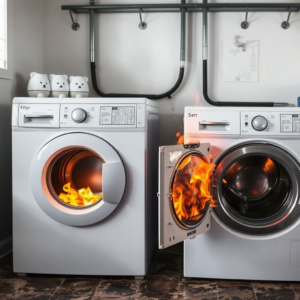Fires from malfunctioning clothes dryers have recently made front-page. News stories in recent times have shown how such sad incidents have left families with no other option but to sell their fire-damaged homes to firms who buy fire-damaged homes. Understanding how do dryer fires start is crucial for preventing these tragic events.
The fire department in Tulsa responded to a residential property regarding a dryer fire that was identified to be due to lint buildup. Thanks to the timely response of the fire professionals, the fire was quickly contained, but it highlighted the dangers of neglecting the routine cleaning of a dryer. Similarly, a fire incident occurred at Lyons Manor, caused by worn or frayed wiring that supplied power to the motor of an exhaust clothes dryer, showing how dangerous such equipment can be in relation to electrical faults.
Understanding how do dryer fires start is crucial for preventing these potentially devastating incidents. Homeowners typically should clean the vents on dryers and check the electrical components for damage. Promptly addressing these fire hazards can go a long way in minimizing the risk. Fire brigades underline that people must stay alert and conduct periodic maintenance of home appliances, noting that a little upkeep can prevent disastrous dryer fires that can affect both the home and lives.
1. Lint Build-Up in the Dryer
Lint is extremely flammable, and the high temperatures inside your dryer can easily ignite it. According to the U.S. Fire Administration, the leading cause of home dryer fires, accounting for 34%, is failure to clean dryers. Clean the lint filter regularly before and after every use. Make it a routine to check and clean your dryer vent and ductwork at least annually.
2. Improper Installation or Venting
Poor installation along with venting may allow heat and lint to accumulate, creating a fire risk. Have your dryer installed by a qualified person who follows the manufacturer’s instructions. Rigid or semi-rigid metal ducting is recommended instead of flexible plastic or foil ducts, which can trap lint more easily and reduce airflow.
3. Overloading or Misuse of Dryers
Overloading the dryer will cause it to overheat. Always follow the manufacturer’s guidelines concerning the number of items that can be placed in a load. Other misuses involve placing items like rubber, plastic, or foam, which should not be dried in the dryer. Be conscious of what you’re putting in the dryer.
4. Electrical Issues
Faulty wiring or electrical components can be a fire hazard. Ensure that your dryer is plugged into the correct outlet and that the wiring is in good condition. If your dryer frequently trips the circuit breaker, it’s a sign that something is wrong and needs to be checked by a professional.
5. Signs of a Potential Fire Hazard
Knowing the warning signs can make a huge difference. Look out for:
- Unusually hot surfaces on the appliance
- Burnt smells or strange noises coming from the dryer
- Clothes taking longer than usual to dry
- Excessive lint behind the dryer
If you notice any of these signs, unplug the dryer immediately and have it inspected by a qualified technician.
6. Prevention Tips to Reduce the Risk of a Dryer Fire
- Clean the lint filter before and after each load.
- Inspect and clean the dryer vent regularly.
- Avoid overloading your dryer.
- Use the right type of ducting, preferably metal.
- Schedule regular maintenance with a professional.
- Be cautious with what you dry—avoid non-clothing items unless specified by the manufacturer.
Conclusion
Knowing how do dryer fires start is necessary in preventing such incidents from occurring. Regular maintenance, such as cleaning the lint filter after each use and having the dryer vent professionally cleaned periodically, combined with proper usage, can significantly reduce the risk of fire. Additionally, being alert to warning signs, like unusual noises or the dryer getting excessively hot, will go a long way in ensuring the safety of your home and family.
In the unfortunate event of a fire, it is also necessary to evaluate the available options. For instance, one can consider looking for businesses that deal in rehabilitating or buying such homes – something that will ease the burden of moving on from the situation. Additionally, it is vital for the purposes of home restoration and recovery to appreciate what the process of reconstructing the home involves after a fire, including things such as appraising the structural integrity, managing the presence of smoke and water, and making the area fit for living once more.
Stay proactive about your dryer’s maintenance and safeguard your home today.
Previous